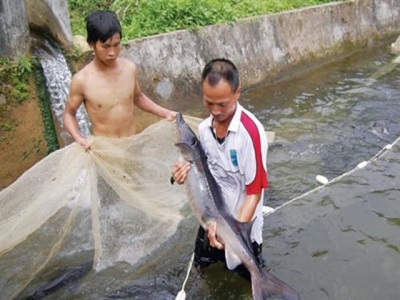Caged-sturgeon breeding brings high incomes to mountainous farmers

Lao Cai - Breeding cold-water sturgeon in cages has brought a stable source of income for poor farmers in the northern mountainous province of Lao Cai.
Farmers harvest sturgeon (Photo: baolaocai)
Hong and Chay rivers which flow through many districts and nearly 30 hydropower dams are considered favourable conditions for expanding caged fish breeding, especially sturgeon, which helps create a food source for the market and incomes for local farmers.
At present, Lao Cai province is home to more than 14,000ha of water and hundreds of hectares of paddy fields which were used for breeding Vietnamese fish such as tilapia, carp and catfish.
Notably, the province had more than 50,000cu.m of water breeding cold-water fish like salmon and sturgeon. The total yield of farmed fish was over 5,000 tonnes per year. However, fish farming in the province faces several challenges.
Dang Danh Bo, an official from the Lao Cai Agriculture Promotion and Service Centre, said that “Most farms are small scale and raise traditional Vietnamese fish with locally-available agricultural by-products.”
“Exploitation of river water sources and reservoirs for fish breeding is not sufficient so the economic value obtained from the practice remains low,” he said.
The National Agriculture Promotion Centre had introduced a model of breeding sturgeon in cages in northern mountainous provinces in 2018-2019.
In Lao Cai province, many ethnic minority farmers have taken part in the production model.
After a year of implementation, the model has proved to be effective in the pursuit of sustainable aquaculture development while bringing about high economic values to the rural districts of Bac Ha, Muong Khuong and Bao Thang, which have suitable climate and an abundance of water resources.
Initially, the centre started with four households to carry out the model of breeding sturgeon in cages as a trial in Coc Ly Hydropower Plant's reservoir in Bac Ha district.
The total volume of the cages was 400cu.m of water and the breeding lasted for 12 months. The households were provided with 3,000 fish breeds and 2,700kg of feed. During the breeding, the fish adapted to the environment and grew quickly.
After a year, the rate of living fish was 70 percent and reaching an average weight of 1.8kg each. With a selling price of 130,000 VND (5.6 USD) per kilo, the total revenue of four households was 415 million VND (17,800 USD), of which profit was nearly 116 million (4,900 USD).
Breeding traditional Vietnamese fish in cages on a similar scale brought profit of just 86 million VND per year. Obviously, the economic value of the sturgeon farming was 34.8 percent higher than breeding other fish. The sturgeons, which were raised in big cages and clean water with safe food, were of better quality.
Bo from the province's agriculture promotion centre said the biggest benefit of the model is the ability to maintain a control over the quality of fish breeds and feed, which will greatly help minimise diseases and protect the eco-system.
Cao Van Luc, a farmer in Coc Man hamlet, Xuan Quang commune of Bao Thang district, swore by the quality of the fish and the revenues it brought in for the family. His family earned a profit of 29 million VND (1,300 USD) per year for every 50cu.m.
Following the initial successes, the National Agriculture Promotion Centre and provincial Agriculture Promotion and Service Centre have been organising field trips and training sessions for 30 potential households in the districts of Bao Yen, Bao Thang, Bat Xat, and Muong Khuong starting this year.
The centres would help households link with businesses to organise eco-tourism, build the brand of Lao Cai sturgeon this year, complete with a stamp proving the products' origin within the year.
Có thể bạn quan tâm
 It’s complicated – reviewing the use of essential oils in aquaculture
It’s complicated – reviewing the use of essential oils in aquaculture Researchers have determined that essential oils can be successfully used as anaesthetics, antimicrobials and antioxidants in aquaculture
 New tool for seafood products that can stand scrutiny
New tool for seafood products that can stand scrutiny Aquafeed company, BioMar, has launched a digital transparency tool, Discover, that potentially allows shoppers to scan an on-pack QR code to access precise info
 Single-cell protein aquafeed ingredient first to gain GRAS designation
Single-cell protein aquafeed ingredient first to gain GRAS designation This is a complicated and onerous process. It’s slowing down the pace of innovation. We need to find the balance between innovation and safety